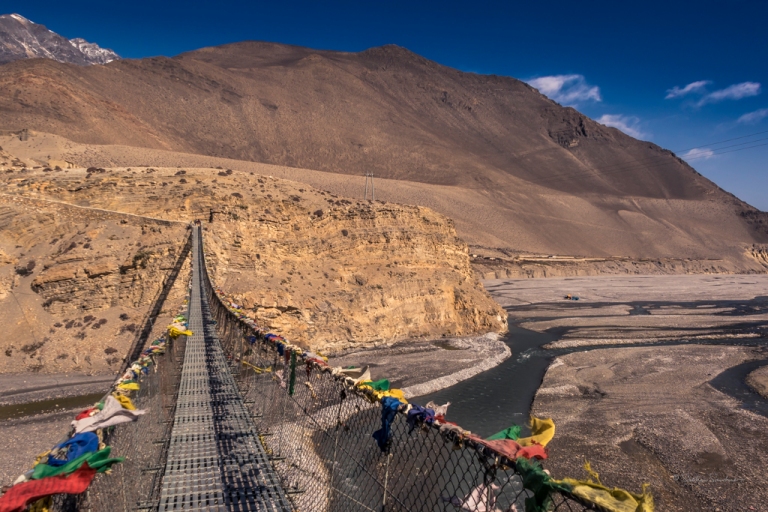When a temple is befittingly titled Muktinath (translated to a place of liberation) you can be certain of two things. Witnessing it in the flesh will be a magnificent experience. And it will certainly not be easy to attain. Nestled at a daunting 12,500feet, this unique temple is one of the earliest Hindu temples dedicated to God Vishnu. It is one of the few places that sees an equal devotion of both the Hindu and the Buddhist community.

Despite being at such an intimidating height it is, somewhat fortuitously, located at the motorable base of the Thorong La mountain pass.

Our journey commences from Kathmandu – the capital city of Nepal. Although motorable, we decided to take a 30-minute flight out of Kathmandu to Pokhara. Our first stop on the destination. After a quick stretch of the legs we were off on to a 175 kms drive from Pokhara right into the Annapurna Conservation Area.

The journey from Pokhara to Muktinath temple is both challenging and visually breathtaking. And it asks of you that you be prepared. Which is why we picked a Tata Safari Storme for this journey. Although the term ‘best SUV’ is loosely used in current times, most cars aren’t genuinely geared up for this kind of journey. The Tata Safari Storme credentials of being “the real SUV”, however, made it the ideal choice for the terrain.

The next stop on our voyage was Beni. A cool 100 kms ahead of Pokhara, the journey was swiftly covered in just a matter of 4 hours. Clearly the tougher terrain lie ahead.
On our halt at Beni we were greeted by the friendly staff at the Tata Motors Service center, who promptly gave our Tata Safari Storme a thorough once-over and declared us fit for the road ahead.


This sent us towards Jomsom – a small town at the base of the Nilgiri Himal (23,166feet). A town often used as base camp for climbers to the mountain, it also hosts a small airstrip, which sees daily flights from Pokhara.


Jomsom is a reasonable 95 kilometers from Beni. But can easily take more than 7 hours depending on the weather conditions. The track roads are not ideal and they snake along the Kali Gandaki river. The Tata Storme, however, went some way in making the journey seem easier than it actually was.


The Nepalese mostly commute on these tough roads on Tata Motors SUV’s like the Tata Sumo and the Tata Safari. Most locals believed that the Tata Safari Storme was the best SUV we could have gotten for the course. Apart from these, the locals only recommend 4×4 SUV’s and other high ground clearance vehicles.

To give you a layout of the landscape, the Kali Gandaki river separates the two major peaks of Dhaulagiri (26,795 feet) and the Annapurna (26,545 feet). The Gandaki river flows through some of its deepest sections. At one point along the way, a short 7 kms from Tukuche, the gorge is claimed to be the world’s deepest.


After a rather chilly night in Jomsom, we leave fresh in the morning for our destination – Muktinath (12,500feet).


Although just a mere 20 km from Jomsom the ride takes us no less than 2.30 Hrs. Owing to the bridge construction being underway(at the time of the travel), we had to cut across through the Kali Gandaki riverbed. An inventive shortcut for those riding a Tata Storme or equivalent.






We finally arrive at Ranipauwa (12,200feet) – a small settlement with quaint cafes, restaurants and souvenirs shops. A nice hot cup of coffee later, we finish our trip with a pleasant 40 min trek upto Muktinath temple.
And as imagined, the experience was one for the ages.
If you have read so far, then for sure, do have a look at a short showreel of journey to Muktinath, Nepal on my Youtube channel. Please do subscribe.

Wish I could have come along. Well written and photographs. .love them.
LikeLiked by 1 person
I luv ur photography…it’s just mesmerising. Need to order another photograph of the mountains.
LikeLiked by 1 person
Sure, anytime dear
LikeLike
Your photos tell a story which even million words wont be able to express this beautiful nature. Hat’s off
LikeLiked by 1 person
Thanks so much, Dilip
LikeLike
Amazing journey and amazing photography. Well done Sachin
LikeLiked by 1 person
Shome, thanks so much
LikeLike
Good news, now the motorable bridge has been constructed at Jomsom to cross the Kaligandaki River.
LikeLike
Yes, I am aware. And the road from Jomsom to Muktinath has also been done up properly.
LikeLike
Beautiful….
LikeLike